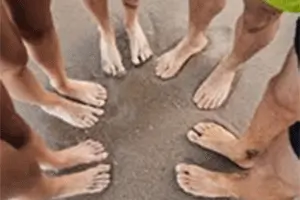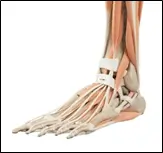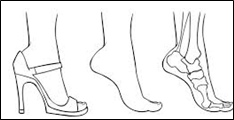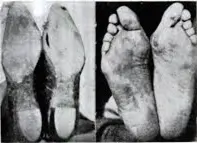
Our feet serve as the foundation of our bodies, providing essential support for our daily activities. Often overlooked – until something goes wrong – our feet are intricate structures designed for movement as well as stability.

Comprised of a whopping 26 bones, over 100 muscles, tendons, and ligaments, our feet are remarkable structures. This foundational role is not only critical for balance and walking, but also for maintaining proper posture and alignment.
Healthy Feet: The Unsung Heroes of Our Daily Life
When we stand, the feet (ideally) distribute our weight evenly, absorbing the impact of movement and acting as shock absorbers. They also provide feedback to our brain about our environment, helping us navigate various terrains.
Healthy feet help prevent strain on other body parts, such as the knees, hips, and back. One example is the correlation between tight calf muscles and low back pain.
The Lost Art of Foot Dexterity
Interestingly, toes and fingers share a very similar structural design, and are therefore capable, at least historically, of sharing a wide range of movements. However, as humans began to walk upright and wear shoes, the functional requirements of the toes (such as grasping objects) changed, and for many of us, the voluntary movements that were once possible have become much more limited.
But there are some modern humans, whether because of dedicated practice or out of sheer necessity who have maintained dexterity in their feet that rival our early human ancestors. Below are two very different examples.
This incredible two-minute video shows a woman born with no arms who does everything with her feet, including washing her hair and dressing her toddler: https://www.youtube.com/watch?v=z-g6Wt5HRIM
This is an amazing (and entertaining) video of someone who has learned to juggle with her feet: https://vimeo.com/184028817
Here Are Some Suggestions on Ways to Help Make Our Feet “Happy”
Footwear: Modern shoes often restrict toe movement, holding them in a position that doesn’t promote natural function. Below are images that tell the story of the influence our choice of shoes have on our feet.

Regular use of high heels can cause foot pain due to the uneven distribution of weight. It also leads to tight calf muscles which can increase stress on the lower back and knees. Other possible problems include the development of corns, calluses, bunions, and an increased risk of falling. It’s advisable to limit the time spent in high heels.

Frequent use of tight-fitting shoes can gradually change the shape of the foot and lead to a variety of problems including bunions, corns, calluses, weakening of the foot arch/arch pain, hammer toes, and ingrown toenails. Choose shoes that fit well and provide enough room for the toes.
Regularly measuring your feet is also important because their size typically changes over time.

Flip-flop wearers beware: The approach of warmer weather typically brings the wearing of backless sandals, which if used as your primary footwear can cause significant problems. This often includes the development of plantar fasciitis, sprained ankles, and falls which sometimes result in fracture.
A Sample of Exercises to Keep Your Feet Flexible and Strong
- Stand on one leg, with or without support: Make sure you hold on to a sturdy object for balance as needed and keep your foot/ankle as still as possible. Try to hold this position for 30 seconds. Repeat on the other side.
- Standing calf stretch: Place one leg forward, and one back. Bend the forward knee keeping the back knee straight. Feel the stretch in the calf and in the back of the knee (in the leg that is behind you). Position your feet far enough apart to feel an adequate stretch. Hold this position for about 20-30 seconds, and then without moving your feet, bend the back knee a bit. You’ll still feel the stretch, but it will be deeper in the calf. Repeat on the other side.
- “Toe yoga”: This refers to a series of exercises that promote flexibility, strength, and mobility in the toes and feet. Here are some examples:
Toe Spreading: Sit comfortably and try to spread your toes apart as widely as possible, then bring them back together. Repeat several times. Can you do this with only your big toe?
Toe Curling: While seated, place a small towel on the floor and use your toes to scrunch it towards you. You can even try grasping small objects like marbles, a golf ball, or even a pencil.
Toe Lifts: Stand or sit with your feet flat on the ground. Lift just your toes off the floor while keeping the rest of the foot grounded and then lower them again. Try to lift only your big toe while keeping the other toes down on the floor.
Heel Raises: Stand with your feet flat, then slowly lift your heels off the ground while keeping the balls of your feet and toes on the floor. Do not allow your ankle to roll outward.
Ankle Circles: While seated or standing, lift one foot off the ground and make circular motions with your ankle, then switch directions. To make things more interesting trace the whole alphabet in the air.
Stretching: Sit cross-legged and gently pull your toes back toward your body to stretch the balls of your feet and your toes.
I saw my toes the other day.
I hadn’t looked at them for months.
Indeed they might have passed away.
And yet they were my best friends once.
When I was small I knew them well
I counted them up to ten
And put them in my mouth to tell
The larger from the lesser. Then
I loved them better than my ears,
My elbows, adenoids and heart.
But with the swelling of the years,
We’ve drifted toes and I apart.
Now gnarled and pale each said “J’accuse!”
I hid them quickly in my shoes.

